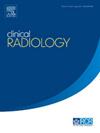Comparison of the consistency between interns in accurate quantification of split kidney glomerular filtration rate
IF 1.9
3区 医学
Q2 RADIOLOGY, NUCLEAR MEDICINE & MEDICAL IMAGING
引用次数: 0
Abstract
AIM
The aim of this study was to evaluate the consistency of an innovative method that combines 99Tcm-diethylene triamine pentaacetic acid (DTPA) renal dynamic imaging with 99Tcm-DTPA dual plasma clearance to precisely quantify the split kidney glomerular filtration rate (sk-GFR).
MATERIALS AND METHODS
154 patients were prospectively included in this study and underwent renal dynamic imaging using 99Tcm-DTPA (Gate’s method, g-GFR) and the dual plasma clearance method (true glomerular filtration rate [t-GFR]). Our team developed an innovative method to precisely determine sk-GFR based on the 99Tcm-DTPA dual plasma clearance method combined with the simplified Gate’s method (g'-GFR). The precise sk-GFR was calculated based on the following formula: precise glomerular filtration rate (p-GFRleft) = g'-GFRleft/(g'-GFRleft + g'-GFRright) × t-GFR. The variability and consistency of sk-GFR, calculated by four interns, were assessed using paired t-test, Pearson’s correlation, and Kendall’s W test. Furthermore, the consistency among the four interns with two methods was assessed across different stages of renal dysfunction.
RESULTS
All four interns used both methods to measure sk-GFR. Although three interns achieved consistent results, one intern reported significantly lower sk-GFR values than the others. Four interns used Gate’s method with a g-GFRleft Kendall’s W coefficient of 0.846 and g-GFRright Kendall’s W coefficient of 0.776. Additionally, they used an innovative method, which resulted in a Kendall’s W coefficient of 0.967 for both p-GFRleft and p-GFRright. The consistency of sk-GFR using the innovative method was higher than that using the Gate’s method at different stages of renal dysfunction.
CONCLUSION
The innovative method provided a standardised procedure for estimating sk-GFR, thereby offering more reliable estimates by less experienced interns.
实习生对裂肾肾小球滤过率准确定量的一致性比较。
目的:本研究旨在评价99tcm -二乙烯三胺五乙酸(DTPA)肾动态显像与99Tcm-DTPA双血浆清除率相结合的创新方法精确量化裂肾肾小球滤过率(sk-GFR)的一致性。材料和方法:本研究前瞻性纳入154例患者,采用99Tcm-DTPA (Gate’s method, g-GFR)和双血浆清除率法(真肾小球滤过率[t-GFR])进行肾脏动态显像。本团队基于99Tcm-DTPA双等离子体清除法结合简化的Gate’s法(g’-GFR),开发了一种精确测定sk-GFR的创新方法。精确sk-GFR按以下公式计算:精确肾小球滤过率(p-GFRleft) = g'-GFRleft/(g'-GFRleft + g'-GFRright) × t-GFR。4名实习生计算的sk-GFR的变异性和一致性采用配对t检验、Pearson相关检验和Kendall W检验进行评估。此外,在不同的肾功能不全阶段,评估了四名实习生采用两种方法的一致性。结果:4名实习生均采用两种方法测量sk-GFR。尽管三名实习生取得了一致的结果,但一名实习生报告的sk-GFR值明显低于其他实习生。4名实习生采用Gate的方法,g-GFRleft Kendall’s W系数为0.846,g-GFRright Kendall’s W系数为0.776。此外,他们使用了一种创新的方法,这导致p-GFRleft和p-GFRright的肯德尔W系数均为0.967。在肾功能不全的不同阶段,创新方法的sk-GFR的一致性高于Gate方法。结论:该创新方法为评估sk-GFR提供了一个标准化的程序,从而为经验不足的实习生提供了更可靠的评估。
本文章由计算机程序翻译,如有差异,请以英文原文为准。
求助全文
约1分钟内获得全文
求助全文
来源期刊

Clinical radiology
医学-核医学
CiteScore
4.70
自引率
3.80%
发文量
528
审稿时长
76 days
期刊介绍:
Clinical Radiology is published by Elsevier on behalf of The Royal College of Radiologists. Clinical Radiology is an International Journal bringing you original research, editorials and review articles on all aspects of diagnostic imaging, including:
• Computed tomography
• Magnetic resonance imaging
• Ultrasonography
• Digital radiology
• Interventional radiology
• Radiography
• Nuclear medicine
Papers on radiological protection, quality assurance, audit in radiology and matters relating to radiological training and education are also included. In addition, each issue contains correspondence, book reviews and notices of forthcoming events.
 求助内容:
求助内容: 应助结果提醒方式:
应助结果提醒方式:


